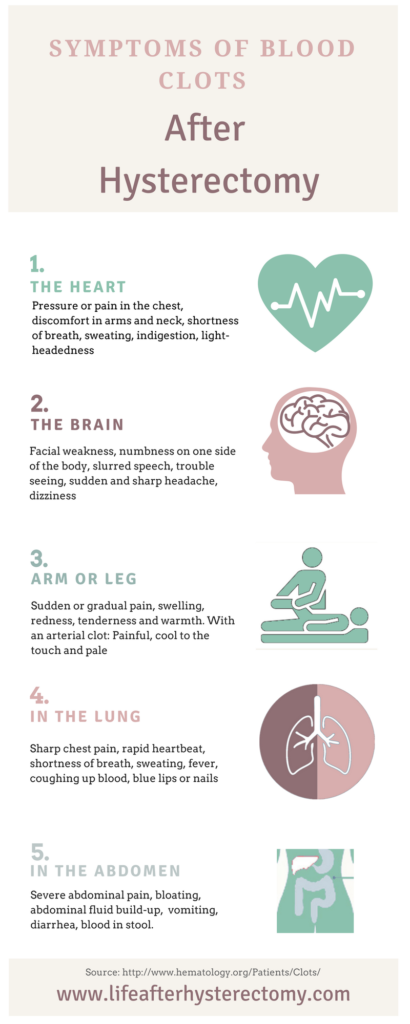Tips to Prevent Blood Clots after Hysterectomy That Can Save your Life
This blog is reader-supported. When you buy through a link on our site, we earn a commission at no extra cost to you. Read more
Developing blood clots after hysterectomy is a risk you have to take into account.
They tend to happen more often after surgical procedures below the waist, in the pelvic area, the hips, and legs. This is especially true for longer-lasting surgeries, let’s say more than 30 minutes.

Not every woman experiences clots in the same part of the body, and thus, not everyone sees the same symptoms. It is important to diagnose the presence of blood clots in a timely manner.
They estimate that roughly between 60.000 and 100.000 people in the US and 25.000 people in the UK die of Deep Vein Thrombosis each year. This is mainly because most people have no knowledge of the vital signs and the risk factors of DVT.
Deep vein thrombosis forms deep in the veins and blocks blood flow to the leg and from the leg back to the heart.
Such a clot can break loose and travel to the lungs, leading to pulmonary embolism. A blood clot in the lungs is a life-threatening complication that we know as a pulmonary embolism (PE) and can result in death if not taken care of in time.
We like to explain how you can prevent blood clots and how to recognize the symptoms of such a life-threatening condition after a hysterectomy.
How Can You Get Blood Clots After Hysterectomy Surgery?
During the hysterectomy surgery, your body is motionless. Without the movement of the muscles, the blood will flow slower through your body. Stagnant blood is more likely to clump together and form a clot. In addition, after the surgery, you are less likely to exercise, walk for long distances, or stretch your legs to enable blood circulation. These are all risk factors that can possibly lead to blood clots in the blood vessels.
In an attempt to prevent blood clots, doctors usually prescribe blood-thinning medications and recommend certain exercises that patients can undertake. Clots are most likely to occur during the first ten days after surgery. But you need to know that the risk, though lower, continues to exist for at least 3 months.
Learn more about hysterectomy risks.
Why Do Blood Clots Occur Despite All The Precautions?
First of all, blood clotting is a necessary process, as a wound would not stop bleeding without it. However, it becomes a major risk if it occurs in the blood circulatory system as it will deprive other parts of the body of nutrients and oxygen.
While necessary steps are taken to prevent the occurrence of blood clots after hysterectomy, some women may still be subjected to the risks.
These include women who have a family with a history of DVT, women who smoke tobacco, and women who have pre-existing conditions such as blood disorders and sugar diabetes. Women with such conditions are likelier to get blood clots, and in such cases, doctors may need to adjust the medications. It is equally important that a patient notifies the doctor of all the existing risk factors.
Furthermore, the surgery itself can lead to blood clots. Debris, collagen, or fat can be released into the blood system, stimulating blood clotting. During the surgery, the veins may get injured or get increased pressure from surrounding tissues, which can also lead to blood clots.
Risk factors for blood clots
Generally, the following are risk factors for getting a blood clot after hysterectomy:
- Family with a history of blood clots
- Obesity
- Oral contraceptives
- The extended time of immobility
- Heart disease and diabetes
- High cholesterol and high blood pressure
How to prevent blood clots after hysterectomy surgery?
Before surgery, you can help to prevent blood clots after hysterectomy by addressing the risk factors. Because obesity is one of the major factors that may lead to the formation of deep vein thrombosis and possibly pulmonary embolism, you can start a weight loss program before undertaking a hysterectomy.
Why are heavier women more at risk? Women with excessive weight generally are less active, which means their blood moves slower. Further, the extra fat is responsible for restricted blood circulation in the veins.
The chemical composition of blood cells is also different in women with a higher weight, which makes them prone to blood clots.
Read also: Weight gain after hysterectomy – Is it unavoidable?
Smoking is known to be a major risk for atherosclerosis. This plaque build-up will reduce blood flow in the arteries and increase the risk of blood clotting. To avoid the risk of blood clots, they recommend you stop smoking at least 3 months before your planned surgery.
If you have a preexisting chronic condition or are taking oral contraceptives, inform the doctors to enable them to monitor your condition more closely.
Other steps you can take to prevent blood clots after surgery include the following:
- Do not sit or lie down in one position for a long time
- In bed, wiggle your toes regularly.
- Elevate your feet if possible
- Take doctor’s medications
- Put on compression stockings if the doctor allows
- Walk around if possible
- Don’t resume smoking right after surgery
- Drink lots of water
- Avoid long trips by plane or car after surgery
Symptoms of Blood Clots after Hysterectomy
Symptoms of blood clots in an infographic:
Treatment for Blood Clots after Hysterectomy
After blood clots have been diagnosed, the doctor may take necessary steps, such as prescribing blood thinners.
Blood thinners (anticoagulants), can help dissolve the clots. Aspirin, heparin, and warfarin are some of the medications they usually prescribe. After a hysterectomy, the doctor will ensure that you follow certain exercises to improve blood circulation. Blood-thinning medication needs monitoring as there is a risk of bleeding if the blood gets too thin. After a hysterectomy, this may cause increased vaginal bleeding.
If you are faced with pulmonary embolism, the doctor may use a duplex ultrasound or MRI scan to observe the extent of the clots, and then intravenous treatment with anticoagulants can begin. Added to this is a mandatory lifestyle change to stick to a proper diet.
Women need to keep a watchful eye on the possible signs of blood clots after hysterectomy. An early diagnosis can save your life. Immediately after the surgery, make it a point to follow the doctor’s orders, keep moving, and follow a proper diet to prevent blood clots. If you have reasons to be concerned about blood clots, then mention this to your doctor.
You may also like
- How to prevent a vaginal cuff tear after hysterectomy
- Tips to Prevent Blood Clots after Hysterectomy That Can Save your Life
- Stressed About Hysterectomy Risks? What Every Woman Must Know
- Hysterectomy Pain After Surgery- Tips To Identify Its Source
- 5 Main causes of bowel problems after hysterectomy


